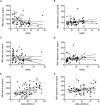Erythrocytic α-Synuclein Species for Parkinson's Disease Diagnosis and the Correlations With Clinical Characteristics
- PMID: 35185529
- PMCID: PMC8850836
- DOI: 10.3389/fnagi.2022.827493
Erythrocytic α-Synuclein Species for Parkinson's Disease Diagnosis and the Correlations With Clinical Characteristics
Abstract
Background: Erythrocytes contain most of the peripheral α-synuclein (α-syn), which is the key pathological molecular of α-synucleinopathies including Parkinson's disease (PD). Our objectives were to assess the efficiency of erythrocytic total and oligomeric α-syn levels as PD diagnostic biomarkers, and to identify the correlations between erythrocytic α-syn levels and physiological/psychiatrical assessment scales.
Methods: Home-brewed electrochemiluminescence assays were applied to assess the concentrations of erythrocytic total and oligomeric α-syn levels in a cohort including 124 patients with PD and 79 healthy controls (HCs). The correlations between erythrocytic α-syn levels and clinical measurements were assessed using Spearman's rank test.
Results: Both the erythrocytic total and oligomeric α-syn levels were significantly higher in PD patients than HCs. The biomarkers adjusted for age and sex discriminated PDs from HCs well with 80% sensitivity, 89% specificity and 79% sensitivity, 83% specificity, respectively. Combining erythrocytic total and oligomeric α-syn levels by using binary logistic regression analysis with the controlling of age and sex generated a factor discriminates PDs from HCs with 88% sensitivity and 85% specificity. The erythrocytic total but not oligomeric α-syn levels adjusted for age and sex significantly correlated with anxiety scales and the MDS-UPDRS III scales in PD patients, respectively.
Conclusion: We showed the usefulness of erythrocytic total and oligomeric α-syn levels as biomarkers for PD. Our results also suggest the capability of erythrocytic α-syn as a potential pathological factor and therapeutic target for psychiatric symptoms in PD patients.
Keywords: Parkinson’s disease; anxiety; depression; electrochemiluminescence; erythrocyte; α-syn.
Copyright © 2022 Yu, Liu, Li, Arkin, Zheng and Feng.
Conflict of interest statement
The authors declare that the research was conducted in the absence of any commercial or financial relationships that could be construed as a potential conflict of interest. The handling editor JL declared a shared parent affiliation with several of the authors, GL, EA, YZ, and TF, at the time of review.
Figures


References
LinkOut - more resources
Full Text Sources
Research Materials
Miscellaneous

